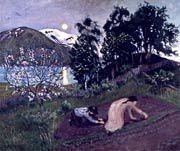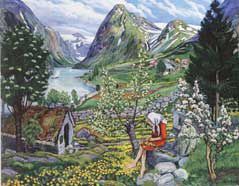Some reflections on what landscape architects can learn from this landscape


Paintings by the norwegian painter Nicolai Astrup who wa sraised as a farmer but had to become a poor artist.
Thinking about this landscape in Montemor and the Landscape Ambassador course as part of a landscape architecture education, I associate with a set of concepts that one of my Danish colleagues, Professor Malene Hauxner, advocates: In her first book on Modernism in Scandinavia “Fantasiens have” (“The Garden of Imagination”), she introduces the idea that gardens are designed either according the aesthetic ideal of cultivation or that of pastoralism. Here in Montemor we find exemplified in an almost archetypical way the origins of those two models: The small scale “hortas” is space that is shaped by cultivation, whereas the Montada is pastoral space, with all its mythical allusions to the Greek Gods of the woods, Pan and Diana, to he Muses, the Elysian fields, etc. In garden history, the idealized equivalents would be the “parterre” of the renaissance or barock on the one hand, and the green lawns and clumps of trees of the classical landscape garden.
What I find particularly important to remember is that in any advanced culture, there will be a continuum between the real and the idealized, both mentally and in concrete real life. So that you should be aware of the connection there is between urban and sophisticated garden and park ideals on the one hand, and the technical know-how and ethics of food cultivation and forestry on the other. I think landscape mangement as we are trying to advocate it in the Landscape ambassador course could play an important role in setting new ideals.
So, in terms of recreational, aesthetic and ecological value dissemination and flow of ideals, could it be that time has come for the urban ideals of landscape management for recreation and amenity to become a model for a much needed healthier and more culturally and biologically sustainable agriculture and forestry practice?
The question arises then: Maybe the farmers and other rural residents and land owners need to be organized in a more urbanized way, that is, with “institutions” and new customs whose task it is to take care of the concern for the public good and of cooperation practices. Otherwise the landscape is going to turn into a battle field.
Landscape ambassadors should be able to come up with ideas to prevent battles in the landscape!

One of the frescos in the Siena Municipal hall by Lorenzetti. Already in the 14th century, the connections between good and bad government was recognized.
